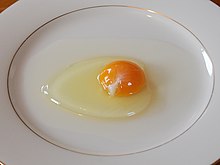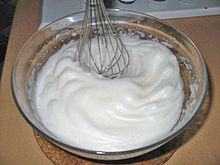Egg white

Egg white is the common name for the clear liquid (also called the albumen or the glair/glaire) contained within an egg. In chickens it is formed from the layers of secretions of the anterior section of the hen's oviduct during the passage of the egg.[1] It forms around either fertilized or unfertilized egg yolks. The primary natural purpose of egg white is to protect the yolk and provide additional nutrition for the growth of the embryo (when fertilized).
Egg white consists primarily of about 90% water into which is dissolved 10% proteins (including albumins, mucoproteins, and globulins). Unlike the yolk, which is high in lipids (fats), egg white contains almost no fat, and carbohydrate content is less than 1%. Egg white has many uses in food (e.g. mousse) and also many other uses (e.g. in the preparation of vaccines such as those for influenza).
Composition
The egg white is about two-thirds of the total egg's weight out of its shell, with nearly 92% of that weight coming from water. The remaining weight of the egg white comes from protein, trace minerals, fatty material, vitamins, and glucose.[2] A raw U.S. large egg white weighs 33 grams with 3.6 grams of protein, 0.24 grams of carbohydrate and 55 milligrams of sodium. It also contains about 17 kcalories[3] and no cholesterol. It contains approximately 40 different proteins.[4] Below is a list of the proteins found in egg whites by percentage, along with their natural functions.[2][5]
- 54% Ovalbumin - Nourishment; blocks digestive enzymes[citation needed]
- 12% Ovotransferrin - Binds iron[citation needed]
- 11% Ovomucoid - Blocks digestive enzymes[citation needed]
- 4% Ovoglobulin G2
- 4% Ovoglobulin G3
- 3.5% Ovomucin
- 3.4% Lysozyme
- 1.5% Ovoinhibitor
- 1% Ovoglycoprotein
- 0.8% Flavoprotein
- 0.5% Ovomacroglobulin
- 0.05% Avidin
- 0.05% Cystatin
(Total listed 95.8%)
Egg white foam

The physical stress of beating egg white can create a foam. There are two types of physical stress caused by the beating them with a whisk, the first being that the whisk drags the liquid through itself, creating a force that unfolds the protein molecules[citation needed]. This process is called denaturation. The second stress comes from the mixing of air into the whites, which causes the proteins to come out of their natural state. These denatured proteins gather together where the air and water meet and create multiple bonds with the other unraveled proteins, and thus become a foam, holding the incorporated air in place. This is because the proteins consist of amino acids; some are hydrophilic (attracted to water) and some are hydrophobic (repelled by water). This process is called coagulation.[6][7]
When beating egg whites, they are classified in three stages according to the peaks they form when the beater is lifted: soft, firm, and stiff peaks. Overbeaten eggs take on a dry appearance, and will eventually collapse. Egg whites will not beat up correctly if they are exposed to any form of fat, such as cooking oils or the fats contained in egg yolk.
Stabilizing egg white foam for culinary purposes
Copper bowl
Copper bowls have been used in France since the eighteenth century to stabilize egg foams. The copper in the bowl assists in creating a tighter bond in reactive sulfur items such as egg whites. The bond created is so tight that the sulfurs are prevented from reacting with any other material. A silver plated bowl will have the same result as the copper bowl as will a pinch of powdered copper supplement from a health store used in a glass bowl. Drawbacks of the copper bowl include the expense of the bowl itself, as well as the fact that the bowls are difficult to keep clean. Copper contamination from the bowl is minimal, as a cup of foam will contain a tenth of one's daily normal intake level.[8]
Adding an acid
Cream of tartar (potassium bitartrate) is an acidic salt that can be used to change the pH of the egg white to an acidic range. This has the effect of stabilizing the foam, and is therefore an alternative to using a copper bowl. About 1/8 teaspoon or 0.5 g of cream of tartar should be used per one egg white to create this effect. One-half teaspoon (2 ml) of lemon juice can also be used to create the same results.[9]
Health issues
Although egg whites are prized as a source of low-fat, high-protein nutrition, a small number of people cannot eat them. Egg allergy is more common among infants than adults, and most children will outgrow it by the age of five.[10] Allergic reactions against egg white are more common than reactions against egg yolks.[11] In addition to true allergic reactions, some people experience a food intolerance to egg whites.[11]
Eggs are susceptible to Salmonella contamination. Thorough cooking eliminates the direct threat (i.e. cooked egg whites that are solid and not runny), but the threat of cross-contamination remains if people handle contaminated eggs and then touch other foods or items in the kitchen, thus spreading the bacteria.
In August 2010, the FDA ordered the recall of 380 million eggs because of possible Salmonella contamination. The Los Angeles Times reported, "With 380 million eggs under recall, consumers may be anxious about eating any egg or food product containing eggs. Here's the upshot: Thoroughly cooked eggs are safe, but cross-contamination could be a problem."[12]
Uses
Egg white is a fining agent that can be used in the clarification and stabilization of wine.
See also
- Albumen print
- Haugh unit, a unit of measure for egg albumen
References
- ^ Ornithology, Volume 1994 By Frank B. Gill p. 361
- ^ a b McGee, 77
- ^ McGee, 79
- ^ Exploratorium
- ^ Takehiko Yamamoto, Mujo Kim, Hen eggs
- ^ Exploratorium.edu
- ^ McGee, 102
- ^ McGee, 102-103
- ^ McGee, 103
- ^ “Egg Allergy Facts” Asthma and Allergy Foundation of America
- ^ a b Arnaldo Cantani (2008). Pediatric Allergy, Asthma and Immunology. Berlin: Springer. pp. 710–713. ISBN 3-540-20768-6.
- ^ Roan, Shari (August 20, 2010). "Eggs and salmonella: What you need to know". Los Angeles Times. Retrieved September 14, 2011.
Works cited
- Elmhurst College, Denaturation Protein
- Exploratorium, Anatomy of an Egg
- Gilbertus. Compendium Medicine Gilberti Anglici Tam Morborum Universalium Quam Particularium Nondum Medicis Sed & Cyrurgicis Utilissimum. Lugduni: Impressum per Jacobum Sacconum, expensis Vincentii de Portonariis, 1510.
- Good Eats, Let Them Eat Foam. DVD. Television Food Network, June 13, 2001.
- McGee, Harold. On Food and Cooking: The Science and Lore of the Kitchen. New York: Scribner, 2004, edited by Vinay.
External links
- How to make albumen photographic paper
 The dictionary definition of albumen at Wiktionary
The dictionary definition of albumen at Wiktionary The dictionary definition of glair at Wiktionary
The dictionary definition of glair at Wiktionary
